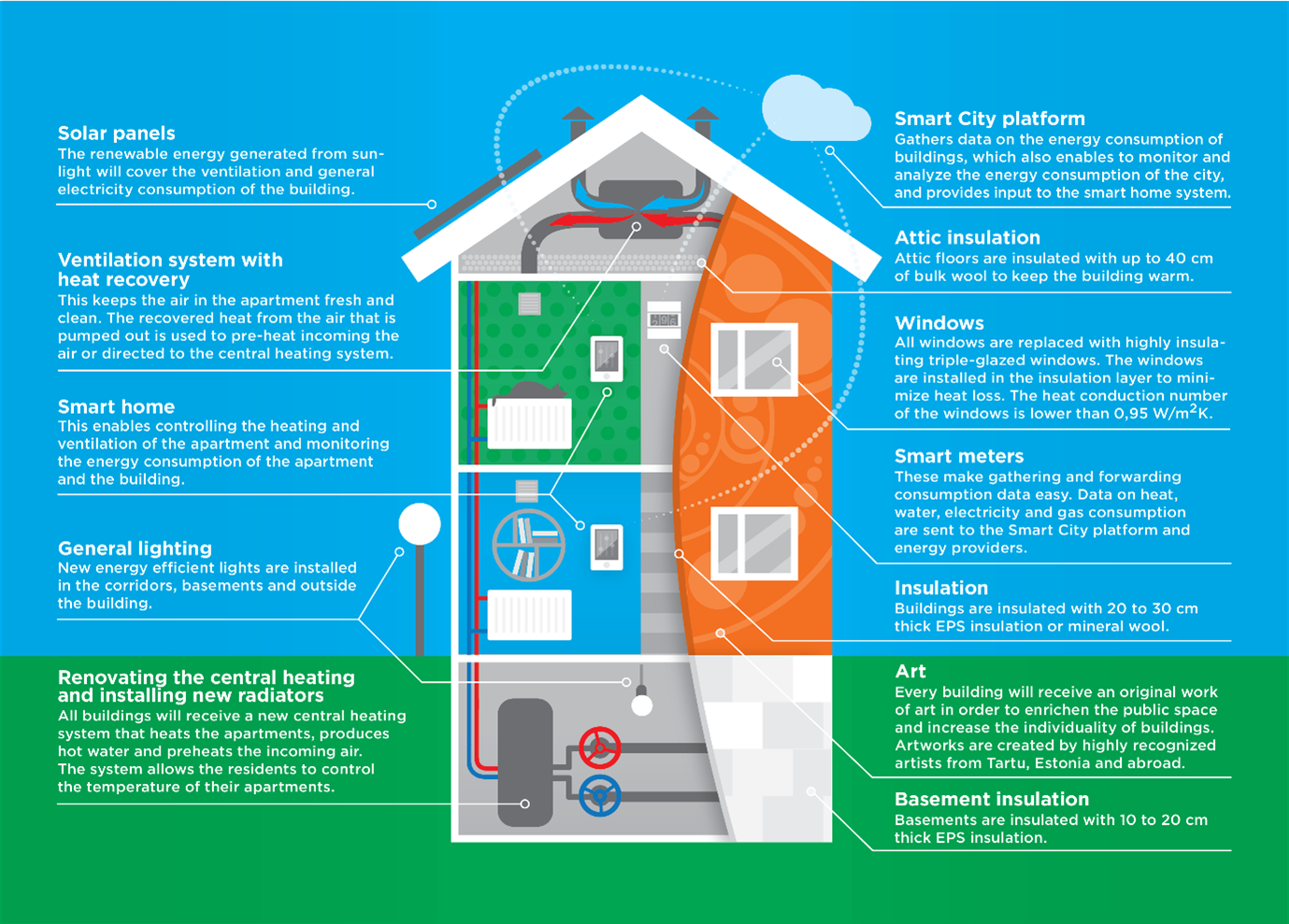Tartu retrofitting package

Main sector: smart buildings
Overview/Plan:
The main idea of Tartu’s lighthouse project was to turn khrushchyovkas (a type of panel buildings that were constructed during the reign of Nikita Khruschchev starting from the 1950s) into smartovkas (i.e. high-quality living environments that inspire the community to make environmentally aware decisions and to change their patterns of consumption behavior) with a drastic reduction in the energy use of the buildings. With an average life cycle of 30-40 years, many of the khrushchyovkas have already outlived their time, meaning that the shortcomings in quality are becoming increasingly evident and might even pose a threat to their residents. Hereby, the SmartEnCity approach proceeds from an understanding that new buildings are constructed according to high contemporary standards and are thus energy-efficient anyways – the true challenge was how to retrofit the old panel buildings that have great energy saving potential.
As a response, Tartu piloted a series of retrofitting solutions in 18 khrushchyovkas in the city center. Increasing the energy performance of the demo area’s housing stock through the smartovka renovation package reduced energy consumption from the current ca. 270 kWh/m2y to 90 kWh/m2y (i.e. meeting class A requirements). The solutions included:
- Insulating all outer walls of the buildings with pre-insulated panels (weighted average level U≤0.22 W/(m2*K));
- Replacing all windows with triple-glazed windows (integrated thermal transmittance level U≤1.10 W/(m2*K)) and adding an insulation layer;
- Replacing all front doors to reduce heat loss;
- Insulating and reconstructing the roofs (heat transfer coefficient U≤0.12 W/(m2*K));
- Installing a ventilation system with heat exchangers;
- Reconstructing the central heating system and installing thermostatic valves that allow to adjust room temperature in the range of 18-23°C;
- Adding low-temperature cooling systems to complement the district heating system;
- Installing 400-500 kWp PV panels to provide additional energy for the buildings;
- Applying art solutions on the facades to increase the aesthetic appeal of the buildings (see more under citizen engagement solutions);
- Setting up a smart home system (see more under ICT solutions).
Outcome/Successful implementation:
Within the framework of SmartEnCity project, 18 apartment buildings were renovated in the pilot area of the project in the centre of Tartu.
The retrofitting included renovation of all technical systems of the house and, at the ende, every building received an original artwork.

Renovated "smartovka" with wall paintings.
Business model:
In Tartu, the renovation activities were funded in combination of H2020 funding (ca. 45%), a national support scheme for renovation activities (ca. 25%) and additional loans taken by the dwelling owners themselves (ca. 35%). The apartments are privately owned and organised into housing associations. Whereas the average price of renovating apartment buildings in Estonia is 250 €/m2, ca. 300 €/m2 is foreseen for this considerably more ambitious retrofitting package.
Citizen engagement:
Besides significantly increasing the energy efficiency of the pilot area buildings, providing a stable interior climate through temperature control and ventilation as well as increasing the aesthetic appeal of the panel buildings, one of the main aims of the retrofitting activities is to encourage behavioral changes in the way residents consume energy and adapt to new technologies. After all, there are not a lot of changes that can be implemented without cooperation and willingness of the users. For boosting participation and interest in the project, several measures have been taken into use, including regular information meetings, technical consultations, study trips to similar construction sites and forum discussions (see more under citizen engagement solutions). Once the retrofitting activities have been completed, these awareness-raising actions of the citizen engagement strategy will be replaced by a social innovation model that focuses on how to motivate residents to use the installed smart devices and to save energy.
Process:

Benefits:
- Increased resource and energy efficiency, smaller energy bills
- Better interior climate (adjustable temperature, fresh air, controlled CO2)
- Autonomy from fossil fuels and independence of energy supply
- Stable long-term return on investment
- Improved data availability, simple monitoring and energy consumption feedback
- New business opportunities
- Increased comfort, behavioral change and social integration (community feeling)
- Increase in the value of the pilot buildings as real estate
- Increase in the quality of the living environment
Stakeholders:
Investment/Finance
Total investment for 18 buildings – 15.6 million EUR
Investment per apartment – 24,800 EUR
Investment per m2 – 445 EUR
SmartEnCity total support – 3.27 million EUR
SmartEnCity support per apartment – 4,734 EUR
SmartEnCity support per m2– 102 EUR
Potential for replication
The retrofitting package tackles one of the greatest challenges of Europe’s existing building stock – quickly deteriorating precast panel apartment buildings that were quickly produced in response to housing shortages. The market and replicability of the respective solutions is enormous, evidenced by the variety of panel buildings in different countries. It is estimated, for example, that 3.5 million people in the Czech Republic and 1.7 million people in Hungary live in these types of apartments. In Estonia alone, there are ca. 6,000 khrushchyovka-type apartment buildings that were constructed between 1961-1990. Tartu, also having a wealth of panel and khrushchyovka-type apartment buildings, aims at piloting the retrofitting package in its central area, after which best practices could be transformed to its residential areas and anywhere else in Europe and beyond.
Facts & Figures
- Retrofitting of 18 buildings -> 35,216 m2
- Heat energy consumption dropped from 166 -> 54 kWh/m2
- Electricity consumption dropped from 39 -> 28 kWh/m2
Lessons Learned
In case of renovation process the prior in-depth planning by owners (apartment association, inhabitants) in cooperation with technical consultants and technical designers becomes increasingly important.
Picture source @ City of Tartu

